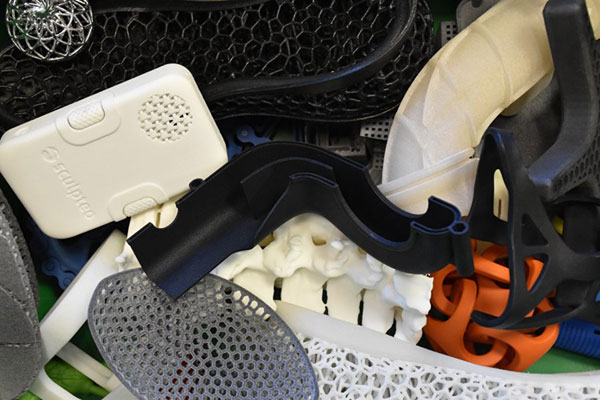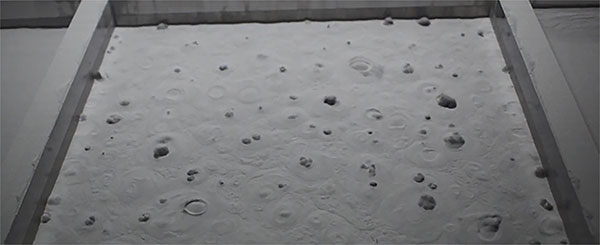Recycling Helps Build Circular Economy for AM
Advances in 3D printer materials handling capabilities and recycling services are helping engineers optimize scrap parts and unused additive manufacturing materials.

The RE-cycleo service lets Sculpteo customers recycle parts printed in Nylon PA 11 and PA 12 to promote a circular economy. Image courtesy of Sculpteo.
Latest News
July 20, 2023
The momentum around sustainable business practices is spilling over into additive manufacturing (AM) as 3D printer companies and materials manufacturers embrace recycling initiatives to promote cost reduction and to establish a greener manufacturing footprint.
Top executives and corporate boards have prioritized sustainability as part of broader environmental, social and governance (ESG) issues, but engineering organizations have been slower to embrace sustainable design practices. Nevertheless, momentum is building as engineering organizations recognize the need to embrace greener design and manufacturing practices, including recycling.
According to Protolabs’ State of Sustainability in Product Development report, 40% of respondents saw AM as a huge facilitator of sustainable design, and more than half (51%) said materials engineering is key to advancing sustainability efforts. Metal AM, and specifically, powder bed AM technologies like direct metal laser sintering (DMLS) and selective laser sintering, have huge sustainability potential because unused powder can be reused in other builds or even recycled to create other materials.
Creating a more circular process for materials handling is now critical for any manufacturing method, not just AM, says Sherri Monroe, executive director at the Additive Manufacturing Green Trade Association. However, a circular economy for AM stands out for sustainability reasons, but also for cost savings and as a way for companies to be more strategic about supply chains and sourcing.
“For some reason, sustainability can feel like taking medicine and people aren’t interested,” Monroe says. “But we look at sustainability as having the same strategic drivers that businesses are looking at any way. Sustainability can mean less energy consumption, less materials sourced, less waste to get rid of, less inventory to hold. Sometimes sustainability initiatives have the fortunate consequence of making a business more efficient, and we’re helping organizations see that.”
Materials Handling Promotes Reuse
Because materials costs constitute a sizable share of the overall AM value proposition, materials waste reduction during production has become an important consideration. Companies are also focused on ways to recycle material for future prints or to channel unused powder, legacy parts and materials waste back into the ecosystem to be repurposed into non-AM related feedstocks for other manufacturing practices like injection molding.
“Recycling doesn’t have to be completely circular and go back into the same process,” Monroe says.v“It could be recycling something that otherwise would be wasted if it matches the materials qualities for that process.”
In the metals AM space, recyclability of materials is critical as the usable life of powder-based materials can be relatively short without the proper atmospheric controls in the printer hardware. Moreover, a significant amount of energy is expended in powder processing—both factors a significant ding on 3D printing’s overall value proposition as a viable production method.
“Without the ability to reuse material within an AM ecosystem, AM becomes an inordinately expensive way to produce something,” says Jeph Ruppert, vice president of technical business development at 3D Systems.
In support of reuse and recyclability, 3D Systems devises efficient schema that allows customers to use the vast majority of materials to make a value-added part. The risk analysis creates profiles for specific materials like titanium or Inconel that characterize effective reuse patterns that don’t jeopardize final materials properties, thus avoiding potential part integrity issues.
“The risk profile identifies potential failure modes and considers particle size, flowability and chemistry changes that could have an effect on the final product or bulk materials,” Ruppert explains. That analysis is then used to drive process controls and schema for each material announced for 3D Systems’ specific AM platforms.

3D Systems’ direct metal printing (DMP) family of metal AM printers is also architected with an eye toward powder recyclability, Ruppert says. The DMP platform’s vacuum chamber concept reduces argon gas consumption while ensuring best-in-class oxygen purity (<25 ppm), which ensures more of the unused powder is recyclable.
In the case of titanium, the DMP vacuum architecture allows for recyclability of material 125 times or more, he explains, which means customers essentially never exceed the shelf life of unused powder.
MolyWorks, which supports circular manufacturing through its Greyhound foundry and recycled Optipowder metals materials, is using the DMP Flex 350 platform in its manufacturing workflows to produce parts for its internal reprocessing atomizer as well as for projects for external customers. For example, the DMP Flex 350 is being tapped to create 3D printed flight-critical parts such as landing gear for the U.S. Air Force.
The DMP Flex 350’s vacuum chamber architecture is particularly critical in titanium part manufacturing, which has become a standard for aerospace applications. The ability to maintain a low internal oxygen level delivers better chemistry control in finished parts and ensures high levels of powder reuse, according to Devin Morrow, director of AM at MolyWorks.
Stratasys’ Selective Absorption Fusion (SAF) production-grade AM printer employs its own techniques to enable powder reuse and recyclability. The less unfused powder is exposed to high temperatures, the more it can be reused, and the SAF-powered H350 printer reduces exposure in two key ways, according to Neil Hopkinson, VP of additive manufacturing technology at Stratasys, and the lead founder of SAF technology.
First, powder is exposed to peak temperature for less time compared to other polymer powder bed systems because SAF’s in-line sequential architecture avoids colder corners that require extra heat that would otherwise be applied to all areas of the bed. In addition, build times are faster, which reduces thermal exposure during printing while smaller build volumes allow for faster bed cooling and reduced thermal exposure, Hopkinson explains. While the impact varies depending on the build, Hopkinson estimates between a 10% to 15% reduction in virgin powder required to produce a kilogram of parts.
Stratasys is also pursuing broader measures that touch on recyclability and materials sustainability. The company’s recently closed acquisition of Covestro will help teams focus on developing more sustainable and biodiverse materials, some potentially taking advantage of recycled parts and materials.
In addition, as part of its Mindful Manufacturing mission, Stratasys is focused on redesigning all its offerings components, printer hardware and materials, with an eye toward reuse and sustainability.
“We’re thinking about how to redesign certain parts of the printer to reduce emissions and waste, which has a bigger environmental impact than recycling,” says Rosa Coblens, Stratasys’ vice president of sustainability. At the same time, Stratasys has a program that promotes recyclability of used cartridges, canisters, spools, print engines and containers.
Recycling Services Makes a Mark
Materialise has several programs that promote plastic 3D printing material reuse and recyclability. Its Bluesint PA 12 program tackles the challenge with selective laser sintering AM processes, where up to 70% of the powder is downcycled or becomes waste. Bluesint is designed to give a second life to the waste powder to create new parts and it also helps reduce CO2 emissions. Each kilogram of standard PA 12 powder generates more than 7 kg of carbon dioxide (CO2), so by reducing the need for new material production, Bluesint PA 12 enables an approximate 30% decrease in CO2 emissions, officials claim.
For the polyamide powder that can no longer be reused, Materialise has entered into a partnership with Arkema, a chemicals manufacturer. The pair analyze the waste to guarantee the quality and consistency of the final recycled product, then re-engineer and recompound the polyamide powder into pellets for injection molding. The material is currently being leveraged to create tubing, luggage and running shoes.
“We want to develop print strategies and processes that ensure all powder ends up as a part,” says Erik de Zeeuw, Materialise market manager for aerospace and a corporate social responsibility ambassador.
Sculpteo’s RE-cycleo Recycling program recycles 3D printed polymer parts to make AM more sustainable. The company also works with Arkema, through its Agiplast operation, to transform discarded 3D parts into new manufacturing materials as part of a push toward a more circular AM economy. Customers of Sculpteo’s on-demand manufacturing services can return parts made out of PA 11 and PA 12 to be recycled and processed.
The 3D-printed parts are sorted based on their material type and then ground down within the Sculpteo manufacturing plant. They are then handed off to Arkema, which performs a compounding process that results in new high-performance material that can be customized to meet specific requirements for strength, flexibility and color.
“We want to promote the use of responsible manufacturing, not making a disposal product,” says Nicolas Mathian, head of marketing at Sculpteo, who cited a custom product like a gripper used on assembly line machinery as a good candidate for recycling as it must be frequently changed and updated.
Companies such as 6K Additive are built on the premise of repurposing metal powders into a full portfolio of new materials for 3D printing—something that’s been possible with more conventional manufacturing methods, but lagged with AM, according to Bruce Bradshaw, 6K’s chief marketing officer.
The company’s UniMelt production-scale process, based on high-frequency microwave plasma, changes the way metal powder is produced through a spheroidization process as opposed to the more common plasma atomization. The result is the ability to synthesize materials that are fully dense with precise controls—ensuring maximum production for AM systems, Bradshaw explains.
“We start with scrap, but we don’t create scrap,” Bradshaw says. “Once the material used in the AM process is put back in the AM process through a newly engineered material, that truly is a circular economy. It hasn't happened before in AM because it wasn’t possible given that the incumbent processes of atomization didn’t allow for a 100% yield.”
6K Additive recently completed its first lifecycle assessments (LCA) for AM powder manufacturing for titanium and nickel powders.
IperionX is also leaning into scrap recycling, coupled with raw materials, to create a cleaner closed-loop system for production of titanium metal powder. Combining novel metal technologies with control over large critical mineral deposits, IperionX aims to reshore the materials supply chain to the United States, starting with titanium.
Titanium’s high strength-to-weight ratio and corrosion resistance make it critical to the aerospace, medical, space and defense sectors, which is why it’s the first focus, says Dominic Allen, the company’s chief commercial officer. Compared to other titanium metal production processes, IperionX’s process achieves yields of nearly 100% from low-grade scrap without having to enlist high-grade primary metal.
IperionX recently won the U.S. Air Force Research Laboratory Grand Challenge, hosted by the Department of Defense’s National Security Innovation Network. This win makes it eligible to produce titanium metal powders from scrap and rejuvenate used or out-of-spec titanium powder for the Air Force for production of parts for advanced weapons systems. In another proof point validating its processes, the company completed an LCA that shows titanium powder produced in its demonstration facility has the potential for a lifecycle carbon footprint of just 7.8 kg of carbon dioxide equivalents per kg.
While recycling has value, in the broad spectrum of sustainability goals, there are other areas where companies also need to direct focus, including on LCA and analysis.
“For customers required to report on their sustainability footprint, it’s important to look at big-ticket items, and recycling is not one,” says Stratasys’ Coblens. “We balance our discussions with customers on their immediate needs and designing future products with a much lower carbon footprint.”
More 3D Systems Coverage
More Arkema Coverage
Subscribe to our FREE magazine, FREE email newsletters or both!
Latest News
About the Author
Beth Stackpole is a contributing editor to Digital Engineering. Send e-mail about this article to DE-Editors@digitaleng.news.
Follow DE





